Many protozoa live in the human body. Many of them are pathogens. Our story is about ten of them, at most. Reviews are based on both history and recent publications.
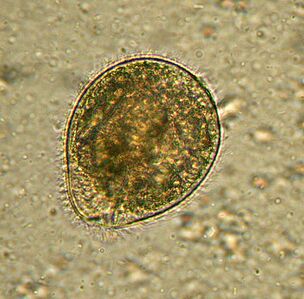
The largest. BalantidiumBalantidium coli
The largest protozoa are the human parasite and the only single-celled species in this company. Its dimensions vary from 30 to 150 microns in length and from 25 to 120 microns in width. For comparison: the length of the largest stage malaria plasmodium is about 15 microns, and several times smaller than the balantidium of intestinal cells, including living cells. An elephant in a porcelain shop.
Scatterwherever pigs are the main carriers. Usually lives in the submucosa of the colon, although in humans, it also occurs in the lung epithelium. It feeds onB. colibacteria, food fragments, and epithelial fragments of the host. In animals, the infection has no symptoms. Patients can experience severe diarrhea with bloody, mucous stools (roundworm disease), sometimes ulcers form on the colon wall. It is very rare to die of roundworm, but it causes chronic exhaustion.
People who become infected through dirty water or food containing cysts. The rate of infection in humans is no more than 1%, while pigs can be infected worldwide.
Treatmentwith antibiotics, there are no reports on the resistance of this ciliate.
Discovered by Swedish scientist Malstem in 1857. Today roundworm disease is associated with tropical and subtropical regions, poverty and poor sanitation.
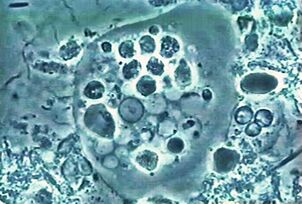
First. Oral amoebaEntamoeba gingivalis
The first parasitic amoeba found in humans. The description of amoeba was published in 1849 in the oldest scientific journal. Found amoeba in dental plaque, hence the name from the Latin gingivae - gums.
Most people livewith a toothache or gum pain, producing gum pockets and plaque. It feeds on epithelial cells, white blood cells, bacteria, and in the case of red blood cells. It is rare in people with a healthy oral cavity.
This small protozoa, 10–35 µm in size, does not go out into the environment and does not form cysts; it is transferred to another host by kissing, through dirty dishes or contaminated food. E. gingivalisis considered the exclusive human parasite, but is sometimes found in captive cats, dogs, horses and monkeys.
In the early 20th century,E. gingivaliswas described as the cause of periodontal disease, as it is always present in inflamed tooth cells. However, its pathogenicity has not been proven.
The drugsaffecting this amoeba are not well known.
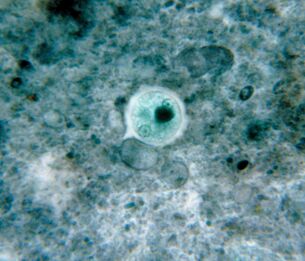
Most popular. Amoeba dysenteryEntamoeba histolytica
This type of intestinal parasite invades the liver, lung, kidney, brain, heart, spleen, and genital tissues. He eats what he will get: food flakes, bacteria, red blood cells, white blood cells and epithelial cells.
Distributioneverywhere, especially in the tropics. Usually, people become infected when the cyst is swallowed.
In temperate countries, amoeba tends to stay in the lumen of the intestine and the infection has no symptoms. In the tropics and subtropics, the pathological process usually begins:E. histolyticaattacks the walls. The reason for the transition to the pathogenic form remains unclear, but some molecular mechanisms of what is happening have been described. So it is clear that amoebas secrete solute, disrupting mucus, and destroy cells. Obviously, amoeba can damage host cells in two ways: by triggering its apoptosis or simply by chewing on the fragments. The first method is considered unique for a long time. By the way, the cell's mechanism of suicide at a record speed - in minutes - has yet to be determined. The second method has been described quite recently, the authors call it trogocytosis from the Greek word "three" - gnaw. Notably, the amoeba bites the cell to remove its prey as soon as it dies. Others may completely phagocytic dead cells. It is thought that the biting and eating cells differ in gene expression patterns.
Now the ability of amoeba to penetrate into the blood, liver and other organs is involved in trohocytosis.
Amoeba is a deadly disease, every year about 100, 000 people die from infection with the bacteriumE. histolytica.
Amoeba dysentery has a non-pathogenic twinE. dispar, so microscopy is not enough to make a diagnosis.
To curemust be destroyedmobile E. histolyticaand cyst.
DescribedE. histolyticaand determined its pathogenic nature in 1875 in a patient with diarrhea. The Latin name of the amoeba was given in 1903 by the German zoologist Fritz Schaudin.Histolyticameans tissue destruction. In 1906, scientist died of an amoebic intestinal abscess.

Most popular. Intestinal lambliaGiardia lamblia (G. Digestive)
Giardia, the most common type of intestinal parasite, is everywhere. 3-7% of people in developed countries and 20-30% in developing countries are infected. That's about 300 million people.
Live parasitesin the host's duodenum and bile ducts, where they float, act with whip parasites, which then attach to the epithelium with the help of a sticky discon the underside of the cell. Above 1 cm2, the epithelium is sticky one million lamblia. They damage the villi, obstruct the absorption of nutrients, cause inflammation of the mucosa, diarrhea. If the disease affects the biliary tract, it will be accompanied by jaundice.
Giardiasis is a disease of hands, dirty water and food. The life cycle of protozoa is very simple: in the intestine there is an active form and in the exit there is a fecal mass, a stable follicle. For an infection, just swallowing a dozen follicles is enough, the intestines will turn into the active form again.
The main secretabout the prevalence of lamblia in the transformation of surface proteins. The human body fights against lamblia antibodies and can, in principle, develop immunity. But people who live in the same area and drink the same water are infected by descendants of their own parasites. Why? Because in the transition from the active phase to the follicle and vice versa, lamblia changes the proteins for which antibodies are made - specific variant surface proteins. There are about 190 variations of these proteins in the genome, but only one variant is always present on the surface of each parasite; the remaining translation is interrupted by RNA interference. And change happens about every ten generations.
It is treatedwith anti-protozoa with antimicrobial activity. The disease resolves after a week, but if the biliary tract becomes infected, it can recur over many years. Cysts are resisted with iodized water.
Discovered by Czech scientist Vilém LamblGiardia lambliain 1859. Since then, the simplest name has changed some names and namesThe present has been accepted in honor of the discoverer and French biologist Alfred Giar, who did not describe lamblia.
And Giardia's first sketch was done by Anthony van Leeuwenhoek, who found it on his own annoying chair. That was in 1681.
By the way, Giardia is also very ancient in terms of evolution, it comes almost directly from the ancestors of all eukaryotes.
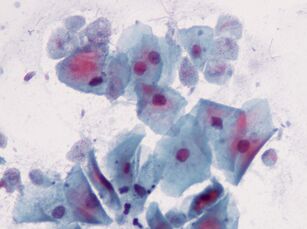
The closest. Trichomonas vaginalisTrichomonas vaginalis.
The simplest, sexually transmitted infection. It lives in the vagina and in men - in the urethra, epididymis and prostate, it is transmitted sexually or through wet towels. The baby can become infected through the birth canal.T. vaginalishas 4 whips on the front end and a relatively short undulating diaphragm, which, if necessary, will release a fake. Trichomonas maximum size is 32 x 12 microns.
Trichomonasis more commonthan chlamydia, gonorrhea and syphilis combined. It affects about 10% of women, and possibly more, and 1% of men. The second number is unreliable because it is more difficult to detect the parasite in men.
T. vaginalisfeeds on microorganisms, including lactic acid bacteria of the vaginal microflora, which maintain an acidic environment and thus create an optimal pH for itself on4, 9.
Trichomonas destroy mucosal cells, causing inflammation. About 15% of infected women complain of symptoms.
Treatwith antibacterial drugs. As a precaution, you should douche often with diluted vinegar.
was described by French microbiologist Alfred Donnein 1836. The scientist does not understand that there is a pathogenic parasite in front of him, but he determines the sizethe simplest form of movement and form factor.
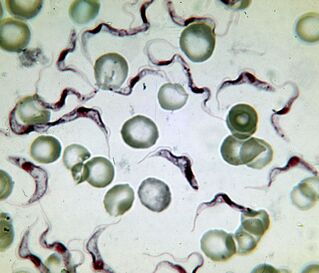
The most deadly. Sleep pathogensTrypanosoma brucei
The sleeping pathogen in Africa is the deadliest protozoa. A person infected with it dies without treatment. Trypanosoma is a whipworm that extends from 15–40 µm. There are two subspecies that are superficially indistinguishable. Disease caused byT. brucei gambiense, lasting 2-4 years.T. brucei rhodesienseis a more virulent, transient pathogen that dies after months or weeks.
Distributionin Africa, between the 15th breeds of the Southern and Northern Hemispheres, in the natural range of the carrier - blood-sucking insect of the genusGlossina(tsetse flies). Of the 31 species of flies, 11 are dangerous to humans. Sleep disease affects the population of 37 countries south of the Sahara, 9 million km away2. Up to 20 thousand people get sick each year. There are about 500, 000 patients, 60 million people living at risk of the disease.
From the fly intestineT. bruceienters the human blood, thereby penetrating the cerebrospinal fluid and affecting the nervous system. The disease begins with fever and inflammation of the lymph glands, followed by coma, drowsiness, muscle paralysis, exhaustion, and irreversible coma.
The lethality of the parasite is related to its ability to cross the blood-brain barrier. The molecular mechanism is not fully understood, but it is known that when entering the brain, the parasite secretes cysteine proteases and also uses some host proteins. On the other hand, in the central nervous system, trypanosomes hide from immune factors.
The first description of sleep disease in the upper Niger River was made by the Arab scholar Ibn Khaldun (1332-1406). In the early 19th century, Europeans were well aware of the early signs of the disease - swollen glands in the back of the neck (a symptom of Winterbottom), and the slave traders particularly noticed it.
DiscoveringT. bruceiScottish microbiologist David Bruce, to whom she was named, and in 1903, he first establishedestablish a relationship between trypanosome, tsetse fly and sleep disease.
Treatmentdepends on the stage of the disease, the drug causes mild side effects. The parasite is highly antigenic, so it is not possible to produce a vaccine.
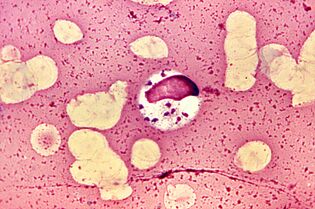
The most lavish. LeishmaniaLeishmania donovani
Leishmanias have earned the title of the most lavish parasites, because they live and reproduce in macrophages - cells designed to kill parasites.L. donovaniis the most dangerous of them all. It causes visceral leishmaniasis, most commonly dumdum fever, or kala azar, from which almost all patients die without treatment. But the survivors enjoy lasting immunity.
There are three subspecies of the parasite.L. donovani Infantum(Mediterranean and Central Asia) mainly affects children, dogs often serving as its reservoir.L. donovani donovani(India and Bangladesh) dangerous to adults and the elderly, without a natural reservoir. The USL. donovani chagasispecies (Central and South America) can live in the blood of dogs.
L. donovani- the same whip has a length of no more than 6 microns. People become infected after being bitten by mosquitoes of the genusPhlebotomus, sometimes through sexual intercourse, babies - passing through the reproductive tract. When entering the bloodstream,L. donovanipenetrates the macrophage, carrying the parasite through the internal organs. Reproducing in macrophages, the parasites destroy them. The molecular mechanism of the existence of macrophages is quite complex.
Symptoms of disease- fever, enlarged liver and spleen, anemia and leukopenia, contribute to secondary bacterial infection. Every year, 500, 000 people get visceral leishmaniasis and about 40, 000 die.
Severetreatment - preparations of intravenous antimony and blood transfusion.
Associated classificationL. donovaniwas identified in 1903 by renowned malaria researcher and Nobel Prize winner Ronald Ross. It has a generic name William Leishman, and a specific name by Charles Donovan, who in 1903 independently discovered single-celled cells in the spleen of patients dying of kala azar, one in London, one in Madras.

The most difficult life cycle.Babesia spp.
Babesias, in addition to the multilayered reproduction in mammalian erythrocytes and sexual ticks in the gut of the genusIxodes, their development is complicated by transmission. through species. From the intestine of the female tick, single-celled spores enter the ovaries and infect the embryo. When the larvae hatch, the babesia enter their salivary glands and with the first bite they enter the blood of vertebrates.
DisperseBabesia in America, Europe and Asia. Their natural reservoirs are rodents, dogs and livestock. A person becomes infected with several types:B. microti, B. divergens, B. duncaniandB. venatorum.
The symptoms of pear form coincide with malaria - recurrent fever, hemolytic anemia, enlarged spleen and liver. Most people recover spontaneously, but cholera can be fatal in immunocompromised patients.
Treatmentsare still under development, while antibiotics are prescribed and blood transfusions are in severe cases.
Babesia was described by Romanian microbiologist Victor Babes (1888), who discovered it in sick cows and sheep. He decided that he was dealing with a pathogenic bacterium that he namedHaematococcus bovis. Babesia has long been considered an animal pathogen until it was discovered in 1957 in a Yugoslav shepherd who died of infection with B. divergens.
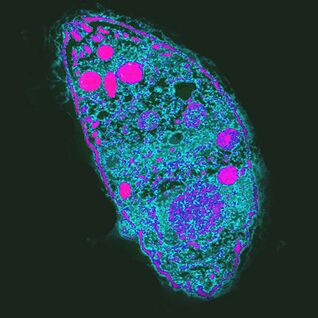
Most influential. ToxoplasmosisToxoplasma gondii
agentT. gondiiis the most powerful parasite because it controls the behavior of the intermediate host.
Scattereverywhere, unevenly distributed. In France, for example, 84% of the population is infected, in the UK - 22%.
The life cycle of Toxoplasma consists of two phases: asexual occurs in the body of any warm-blooded species, sexual reproduction can only occur in the epithelial cells of the cat's intestine. As long asT. gondiican complete its development, the cat must eat the flesh of the infected rodent. By increasing the likelihood of this event,T. gondiisuppresses rodents' natural fear of the smell of cat urine and makes it appealing by targetinginto a group of nerve cells in the amygdala. How she does that is unknown. One of the mechanisms of action is thought to be the local immune response to infection. It alters cytokine levels, thereby increasing levels of neuromodulators such as dopamine. Toxoplasma also affects human behavior, manifested even at the population level. Thus, in countries with high levels of toxoplasmosis, neurosis and the desire to avoid uncertainties, new situations are often more common. Infection withT. gondiicould lead to cultural changes.
Infectionin humans is usually asymptomatic, but with weakened immunity it destroys liver, lung, brain, retinal cells, causing acute or chronic toxoplasma infectioncount. Infection depends on the virulence of the strain, the state of the host's immune system and its age - the elderly are less likely to haveT. gondii.
Treatof toxoplasmosis with anti-protozoa.
Describedin 1908 in desert rodents. This honor goes to the staff of the Tunisian Pasteur Institute Charles Nicolas and Luis Manso.
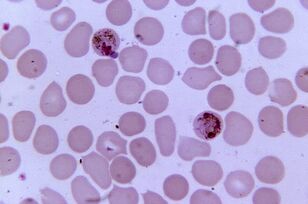
Most pathogenic. PlasmodiumPlasmodium spp.
Plasmodium malaria is the most common human parasite. The number of malaria patients can reach 300-500 million people and the death rate during outbreaks - 2 million. The disease still claims three times more lives than armed conflicts.
Five types of Plasmodium that cause malaria in humans:Plasmodium vivax, P. falciparum, P. malariae, P. ovaleandP. knowlesi, which also affect monkeys.
Scatterwithin the vector range - mosquitoesAnopheles, requiring a temperature of 16–34 ° C and a relative humidity of more than 60%.
Comparing the genome of a unique plasmodia species,P. falciparum, to gorilla plasmodia shows that humans were infected by its ancestors from these monkeys. The emergence of this type of Plasmodium is closely linked to the emergence of agriculture in Africa, leading to an increase in population density and the development of irrigation systems.
sexual reproduction plasmodia occurs in the intestines of mosquitoes, and in the human body, it is an intracellular parasite that lives and reproduces in liver cells and red blood cells until the cell ruptures. 1 ml of the patient's blood contains 1-50, 000 parasites.
The disease has inflammatory manifestations, recurrent fever and anemia, pregnancy will be dangerous for mother and fetus. Infected epidermal cellsP. falciparumclog capillaries, and in severe cases, internal organs and tissues develop ischemic.
Treatmentrequires a combination of drugs and depends on the specific pathogen. Plasmodia becomes resistant.






































